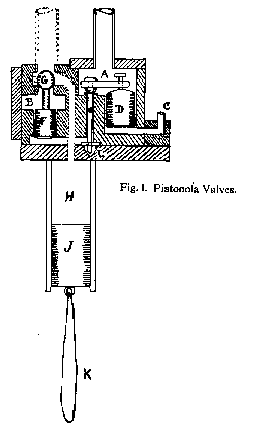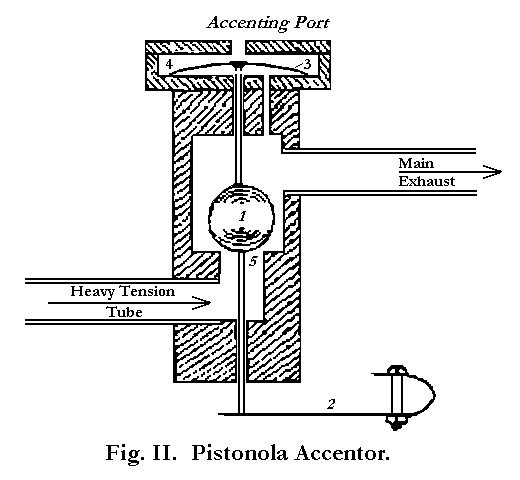| You Are Not Logged In | Login/Get New Account |
|
Please Log In. Accounts are free!
Logged In users are granted additional features including a more current version of the Archives and a simplified process for submitting articles. |
|
MMD
 Gallery
Gallery
 Pictures
Pictures
 Pistonola
Pistonola
 pistonola_descr2
pistonola_descr2
|
|
courtesy Keith Pritchett Reproduced from the 1921 book
HOLDING an eminent position among the player pianos of the day, the Pistonola possesses features which carry with them the hallmark of a great amount of careful thought. As its name implies, the principle of the collapsing bellows in obtaining the necessary energy is entirely dispensed with; and from the main power, obtained by the usual pedal operation to the units engaging the action of the piano, the piston is employed throughout. Quite recently, a writer in an American trade paper said: "It is plain that the bellows type of exhauster and equaliser has many disadvantages inherent in itself. It is leaky, it is hard to move and it is incapable of sustaining great pressure. Its one and only advantage is that it does not need an elaborately thought-out new design. Now, it is plain that, for instance, a steel cylinder fitted with an accurately ground piston would be a much better vacuum device than the ordinary bellows. Such a piston in such a cylinder could be moved by the foot quite as readily as the bellows; it would not be so leaky and it could be moved both rapidly and silently. It would also have the very great advantage of taking up much less space. Moreover, since the thrust would be vertical and not horizontal there would not be the present strain on the fastenings, with inevitable loosening sooner or later." The writer then goes, on to state that the pistons necessary for such work could be constructed of hardened graphite. Now, this is exactly what we find in the Pistonola; and when we remember that the aim of inventors in the player piano industry is to occupy as little space with the completed article as possible, compatible with efficiency, the manufacturers of the Pistonola have every reason for pride in their production. The Pistonola is an all-metal British player, adapted to accommodate standard and fully accented rolls. It is capable of being fitted inside any underdamper piano; and as it occupies very little space it does not interfere with or choke the tonal qualities of the piano to any appreciable extent. When we contemplate the ordinary bellows pneumatic, and realise that under exhaust the outer atmosphere is pressing not only against the moveable leaf but also against the collapsing sides, and then compare it with the effect on one end only of a piston, it is not difficult to believe that the cylinder and piston develop an energy twenty-five times greater than that obtained from the bellows pneumatic. As before mentioned, the pistons are made of hardened graphite, with a glass-like surface, and possess the great advantages of being self lubricating, impervious to damp or heat, and have given proof that after several years' use they have in no way worn or deteriorated. The primary and secondary valves are of brass, fitting freely into their cylindrical recesses; and situated just beneath the primaries are dust-proof sieves to prevent any foreign matter affecting the movements of the valves. In the accompanying sketches I have had to enlarge greatly and distort the, channels, &c., as in the Pistonola itself some of the channels are very little larger than a pinhole. As an instance of the extraordinary responsiveness of the Pistonola, I punctured a roll with the mere point of a needle, and yet this was sufficient to obtain an immediate and decisive blow. And now let us examine the instrument from the source of power to that point where player ends and piano begins. The pedals are connected by tapes passing over eccentric rollers (which ensure the maximum stroke) to two heavily weighted pistons which resemble an inverted bicycle pump, employing similar leather washers. In the centre is the equalising piston, which owes its tension to a powerful spiral spring. The equaliser, as in other players, carries on the work as one pedal relieves the other and its duty is to prevent a spasmodic result. Just beneath these cylinders are the main exhaust tubes, about 1/2 in diameter, instead of 1-1/4 in, as usually employed. One of these tubes leads to a shallow drum like cylinder, just to the right of the treble pedal piston. This is the motor governor, and the piston is held up by a spiral spring, adjustable by means of a locknut to the desired tension (that of 7 ft. a minute, with the roll and indicator at 70). Extra pressure on the pedals draws down the piston against the spring and reduces the amount of power from the motor tube. This tube leads up to the motor, situated on the right of the spool box. This dainty piece of mechanism is about 6 in. wide and 1-1/2 in. in depth. It consists of four pistons, 1-1/4 in. in diameter, and two slide valves. The pistons are brought under exhaust, or released by open air, through four ports of about 1/4 in diameter. The throw of the crank is about 5/8 in. When we consider the usual motor port of approximately 1 in. by 3/8 in., and the vast amount of air being swallowed during its operation, the advantage of a 1/4 in. port is too obvious for further comment. The motor engages the spindle and spool by direct cog and mesh gearing, obviating the employment of chains. Reverting to the pedal cylinders, we will follow the exhaust tube that leads up to the low-tension governor. Attached to the right hand side of the piano above the wrest pins, is a diaphragm governor connected to a slide valve, which is regulated by an adjustable blade spring. It is extremely sensitive and under heavy pedalling cuts down the amount of power; but under light pedalling permits the spring to open the slide valve, thus maintaining an absolute regularity of vacuum Its duty is to operate the primary valves, and it is connected by a tube to the front metal tube running the whole length of the player. From this metal tube, connections are made with each section of valves - nine in number - and it exhausts the air from the chamber (A, Fig. I.). Another main exhaust tube leads from the pedal pistons up to the tube marked Main Exhaust (Fig. II.). From this accenting device, the heavy tension is the rear metal tube, and by similar connections in each piston section exhausts the air from B (Fig. I.) There are two of these accentors, one at each end of the player, and in their operation they differ completely from those accenting devices I have already described. The Pistonola accentor emphasizes the melody notes without cutting down the tension. The treble and bass buttons, also, do not reduce but increase the power. If you glance at Fig. II, I will endeavor to make it clear. The ball governor is there at normal wind, ample power being obtained through the port 5; but on pressing the treble or bass button air rushes to the primary and secondary (not shown in the sketch), exhausts the accenting port and allows the spring (2) to push up the ball governor and obtain a greatly increased air power through the port (5). Similarly the marginal perforations in the accented music roll carry out the same scheme. The tension spring (2) can be adjusted by its screw, to increase or reduce the normal power. Look beneath the key bed again, and on the extreme right and left will be seen two drum-shaped cylinders with primary and secondary valves precisely similar to the accentor, only containing a piston instead of the ball governor. These pistons operate the sustaining pedal and the hammer half blow; both being operated either by buttons at the keyboard or perforations in the fully accented roll. The control is effectively simple and consists of the sustaining button, the piano or half-blow button, loud bass button and loud treble. A phrasing lever, beautifully responsive, increases or diminishes speed from presto to the halt, and the tempo lever. In the spool box is the " play" or "rewind" lever and also the automatic sustaining lever. The whole player mechanism is wonderfully responsive and noiseless, and in my humble opinion marks a decided advance on those with which I have come in contact hitherto. For tuning purposes, it is only necessary to release two large locknuts above the spool box and two screws (one at each end of the piano) holding the angle iron, and the player action swings forward, giving access to the wrest pins and piano action.
A state of vacuum of light tension is produced in the chamber A; of heavier tension in the chamber B. The roll admits air into the tube C, and the primary valve D is drawn up, lifting the coned pin E, destroying the vacuum in the air channel beneath the cone. The secondary valve F is then drawn up by the heavier vacuum, thrusting up the ball valve G, This ball shuts off open air and brings the cylinder H under powerful vacuum, drawing up the piston J, which lifts the piano lever by means of the loop K. When the roll covers the tracker duct, the air pulse beneath the primary D is immediately absorbed round the sides of the valve, which drops into the original position, closing the air channel to the secondary. The countersunk holes L, beneath each pinpoint, are connected one with another by grooves, and also to the heavy vacuum chamber B, and on the conclusion of a note, they absorb any air in the channels, thereby ensuring a most effective repetition.
The ball governor 1, is held in equilibrium by the spring 2 and the diaphragm 3, the latter being drawn down against the spring by the vacuum. A primary and secondary (similar to Fig. I., without the piston) exhausts the air chamber 4, and permits the spring to thrust up the ball, increasing the power through the port 5.
10 March 2000 |
|
|
|
|
|
|
|
|
|
CONTACT FORM: Click HERE to write to the editor, or to post a message about Mechanical Musical Instruments to the MMD Unless otherwise noted, all opinions are those of the individual authors and may not represent those of the editors. Compilation copyright 1995-2026 by Jody Kravitz. Please read our Republication Policy before copying information from or creating links to this web site. Click HERE to contact the webmaster regarding problems with the website. |
|
|
||||||
|

